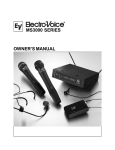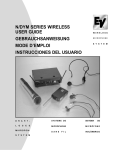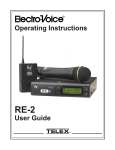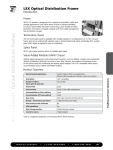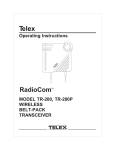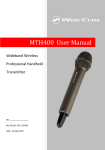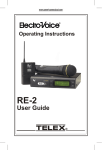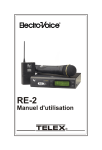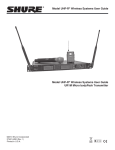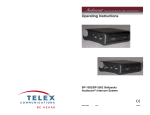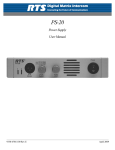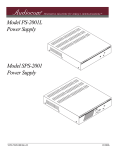Download Telex ur-700 Marine Radio User Manual
Transcript
Telex ® Operating Instructions UR-700 GENERAL INFORMATION The Telex Model UR-700 Receiver and associated Transmitters is a full diversity system operating within the frequency range of 690 to 725 MHz on specific pre-set frequencies. Systems consisting of the UR-700 and its companion transmitter are capable of operating on at least 5 frequencies in a TV channel simultaneously, sometimes more depending on the individual venue. Certain frequencies can be combined to form a set of systems compatible for simultaneous use. Posi Phase Diversity The UR-700 receiver utilizes Telex’s patented Posi Phase auto diversity circuit. Unlike other types of diversity which receive with only one antenna at a time, Posi Phase utilizes both antennas at all times. This results in a stronger signal from the microphone for cleaner audio and greater range. If the microphone signal begins to go out of phase (a common cause of “drop outs” with other types of diversity) the Posi Phase circuit adjusts the phase angle between the two antennas’ receiving circuits to prevent phase cancellation. This action is indicated by the 0 and 180 degree diversity lights on the front panel Antennas There are two TNC type antenna connectors on the rear panel. These connectors are superior to the more common BNC connectors, both electrically and mechanically. TNC connectors are becoming the standard due to their heavy use in the Cellular Phone industry. Quarter wave antennas are supplied for normal use or an optional antenna accessory kit can be used to rack mount the antennas. Optional half wave antennas with coax can be used for remote installations. Both antennas must be used as both are active at all times, unlike other types of diversity that only use one antenna at a time. -1- Displays 1. A 5 segment LED light array for AF that aids in setting microphone gains and monitoring receiver microphone and line level outputs. Light numbers 4 and 5 have a Peak Hold feature. 2. A 1 segment LED light for RF that aids in checking the transmitter and monitoring for the possibility of initial interference. 3. A 2 segment LED array that indicates diversity action and antenna configuration. Audio Outputs An XLR type connector and 1/4" phone jack are located on the rear panel providing either line level or microphone level audio output. The line output level is adjustable with a screwdriver accessible potentiometer. Power The UR-700 will operate from the supplied AC adapter or any nominal 12-15 volt AC/DC 300 mA supply. Audio The UR-700 audio circuitry is designed to complement the transmitter audio. A compandor circuit is utilized to enhance the dynamic range. -2- UR-700 Receiver Specifications Frequency Range. . . . . . . . . . . . . . . . . . . . . . . 690-725 MHz R.F. Stability . . . . . . . . . . . . . . . . . . . . . . . . 0.005% or better Modulation Type . . . . . . . . . . . . . . . . . FM, 40 KHz nominal Type. . . . . . . . . . . . . . . . . . Single Conversion, 10.7 MHz I.F. I.F. Bandwidth. . . . . . . . . . . . . . . . . 230 KHz at -3 db points. Image Rejection . . . . . . . . . . . . . . . . . . . . . . . 65dB or better Squelch . . . . . . . . . . . . . . . . . . . . . . . . . . . . . . . . . Amplitude Audio Output . . . . Line Level: 0.775V RMS/100k load (MAX.) Mic Level: -20 dBV, 600 Ohm load Receiver Sensitivity . . . Less than 0.8 uV for 12 dB SINAD FCC . . . . . . . . . . . . . . . . . . . . . . . . . . . . Notification, Part 15 Diversity . . . . . . . . . . . . . . Continuous Posi Phase Diversity Both antennas are fully employed at all times to maximize signals. FCC I.D. . . . . . . . . . . . . . . . . . . . . . . . . . . . . . . . . B5DR307 -3- Model HT-700 Transmitter Specifications Power Output (Terminated). . . . . . . . . . . . . . . . . . . . 10 mW, Antenna . . . . . . . . . . . . . . . . . . . . . . . . Permanently attached. Modulation . . . . . . . . . . . . . . . . FM, +/- 40 KHz Deviation, 50 us pre-emphasis. Frequency Response (System) . . . . . . . . 50 Hz to 15000 Hz Microphone . . . . . . . . . . . . . . . . . . . . . . Dynamic or Electret DC Power . . . . . . . . . . . . . . . . . . . . 9 volt Alkaline Batteries Battery Life . . . . . . . . . . . . . . . . . . . . . . . . . . . . 8 to 12 Hours Approvals . . . . . . . . . . . . . . . . . . . . . . . . . . . . FCC, Part 74H Industry Canada, RSS123 FCC I.D. . . . . . . . . . . . . . . . . . . . . . . . . . . . . . . . B5DH208A -4- Model WT-700 Transmitter Specifications Power Output (Terminated). . . . . . . . . . . . . . . . . . . . . 10 mW Antenna . . . . . . . . . . . . . . . . . . . . . . . . Permanently attached Modulation . . . . . . . . . . . . . . . . . FM, +/- 40 KHz Deviation, 50 us pre-emphasis. Frequency Response (System) . . . . . . . . 50 Hz to 15000 Hz Microphone . . . . . . . . . . Dynamic or Electret, + 5 VDC Bias Microphone Sensitivity . . . . . . . . . . 7.8 mV for full deviation DC Power . . . . . . . . . . . . . . . . . . . . 9 volt Alkaline Batteries Battery Life . . . . . . . . . . . . . . . . . . . . . . . . . . . 8 to 12 Hours Approvals . . . . . . . . . . . . . . . . . . . . . . . . . . . . FCC, Part 74H Industry Canada, RSS123 FCC I.D. . . . . . . . . . . . . . . . . . . . . . . . . . . . . . . . B5DB108A -5- Figure 1 Front Panel Power Switch: When turned on, one of the diversity lights will illuminate. RF Display: A 1-segment LED Display indicates the presence of the signal from the transmitter. Diversity Display: LED’s indicate diversity operation. AF Display: A 5-segment 3 color LED Display indicates the relative modulation of the microphone. Squelch: Adjustable for maximum range or minimum interference. -6- Figure 2 Rear Panel Antenna Jacks: Two antenna jacks for posi phase diversity reception. Attach an antenna to each jack. Mic Level: XLR type jack connects to balanced mic input of audio sound system (Amplifier/Mixer). Pin 1 ground, Pin 2 +, Pin 3 -. Line Level: 1/4" jack with screwdriver adjustable unbalanced audio output. Use supplied screwdriver to adjust to desired level. Power Jack: For external AC wall supply adapter (supplied). Will accept 12-15 volts AC/DC at 300 mA. Plug size is 2.1mm x 5.5 mm. Power Cord Retainer: To prevent accidental pull out of the power plug. -7- Receiver Set-up Connect the supplied AC power adapter to an AC outlet supplying 105 to 125 volts AC, 60 Hz. The 230 volt export model should connect to an AC outlet supplying 210-240 VAC, 50-60 Hz. Connect the UR-700 to your equipment: Insert the appropriate audio connector and cable into the mic or line receptacle on the rear of the UR-700. Insert the other end of the audio cable into the input of your Mixer/Amplifier. If utilizing the two 1/4 wave antennas supplied, connect both of them to the back of the receiver at a 90 angle as shown in Figure 3. Tighten the connectors securely. (If using other types of antennas, refer to the placement instructions on page 14 of this manual.) Figure 3 Antenna Mounting -8- Figure 4 HT-700 HT-700 Power and Mute Switches: Located on the bottom of the handle. Microphone Gain: Controls the gain of the audio circuit to prevent under or over modulation. Set-Up NOTE: Do not use carbon-zinc batteries. 8.4 volt Ni-Cad batteries may be used but will yield shorter run times. Unscrew the handle and install a 9 volt alkaline battery. Be sure the battery polarity matches the diagram inside the battery holder. Screw the handle back on. Do not turn on at this time. -9- Figure 5 WT-700 WT-700 Power and Audio Switches: Located on the top of the case. Microphone Gain: Controls the gain of the audio circuit to prevent under or over modulation. Microphone Jack: wired as follows: Pin 1 Ground Pin 2 Mic Pin 3 +5 volt bias Pin 4 +5 volt bias fed through a 3K ohm resistor for 2 wire electrets. -10- Set-Up NOTE: Do not use carbon-zinc batteries. 8.4 volt Ni-Cad batteries may be used but will yield shorter run times. Open the battery door and install a 9 volt alkaline battery. Be sure the battery polarity matches the diagram inside the battery holder. Close the battery door. Insert the microphone plug into the connector. Do not turn on at this time. System Set-Up NOTE: When employing two or more wireless systems, the microphones should be a minimum of 10-15 feet away from the receivers to prevent “front-end” overload. Turn on the receiver. Check the RF light. If it is on, this indicates potential interference. The squelch control on the front of the receiver may be adjusted to increase range or reduce interference. Turn the control counter-clockwise to increase range. CAUTION! DOING SO WILL MAKE YOUR SYSTEM MORE SUSCEPTIBLE TO OUTSIDE INTERFERENCE! Turn the control clockwise to reduce interference from noise and out side radio signals. It is best to set the squelch with the transmitter turned off. Turn the control counter-clockwise until you hear noise or interference over your sound system. Then turn it clockwise until the noise is squelched off. This setting will give you your best interference free range. Remember, too much squelch will reduce range. Turn on the microphone power switch. When the power switch is turned on, the battery light will flash one time if the battery is good. If the light does not flash or stays lit continuously, the battery is weak or dead. If the light comes on during use, the battery is weakening and should be replaced as soon as possible. -11- The RF light on the receiver should now be illuminated. Turn on the audio (mic) switch. Speak into the microphone and adjust its gain so that the Audio Meter on the receiver just illuminates the 0 (or yellow) light on the loudest sounds. If necessary, vary the line level on the back of the receiver to suit your equipment. Walk the transmitter through the expected use area to check for “drop-outs”. To minimize the chance for drop-outs, read the section on antenna placement. Antenna Placement The antennas and UR-700 should be placed in a location with a clear “signal path” to the transmitter. This “path” should be as short and free of obstructions as possible. Obstructions, such as walls, ceilings, and metal objects, will reduce range and performance. Do not rack mount the UR-700 with the antennas attached directly on the back of the unit. This will severely decrease the range and performance of the system. Antenna Placement for Optimum Range and Rack Mounting For better range and when rack mounting, the antennas must be located on the front of the rack mounts or use optional ground independent antennas and remote mount them. See the accessories section of this manual for cable kits to front mount the antennas. Remote mounting antennas will increase the effective reception range when appropriately positioned. The two 1/4 wave antennas supplied are not ground independent and therefore not appropriate for remotemounting. See the accessories section of this manual for remotemountable antenna options. -12- The diversity antenna system operates most efficiently when the two antennas are separated as much as possible. The antennas should be mounted so that they are at least 6 feet (2 meters) apart for best results. They should be at least 2 feet (60 cm) from nearby objects. Accessories for remote antenna mounting are listed in the back of this manual. See Figures 6 and 7 for suggested mounting options. Bracket Mounting The antenna brackets may be either mounted on mic stands or secured to some other object with the hardware provided. Figure 6 Bracket Mounting -13- Figure 7 Antenna Placement with Accessory Brackets and Cables If possible, do not mount the brackets on a wall. See Figure 7 for bracket and antenna placement. Antenna Connection Attach the two antenna cables to the back of the UR-700. Be sure the connectors are tightened securely. Route the cable to the antennas and attach in the same manner. -14- Installing Rack Mounts The UR-700 is supplied with rack mounts for both double and single mounting in a 19" equipment rack. For single mounting, the long and short rack “ears” are used. For dual mounting, use the short “ears and the mid brackets from two UR-700’s. Item No. 1 2 3 4 5 6 Description Rack Ear, short Mid Bracket Rack Ear, long Screw, #6-32 x 3/8" Phillips, pan head Screw, #6-32 x 3/16" Phillips, flat head Screw, #10-32 x 3/8" Phillips, pan head Figure 8 Assembly of Rack Mount Assembly To assemble the rack mount to the unit(s) and install it into a 19" rack, proceed as follows: Remove the front Phillips head screws from each side of each unit. Refer to Figure 1. Align the rack ear (Item No. 1 or 3) with the holes on the side of the unit. Install the previously removed screws. Insert an additional screw (Item No. 4 provided in the parts pack) into the remaining hole. Repeat this step for the opposite side of the unit. Tighten all screws securely. -15- Double Mounting: Align the mid brackets (Item No. 2) with the holes on the adjacent sides of each unit. Install the previously removed screws. Insert an additional screw (Item No. 4 provided in the parts pack) into the remaining holes. Tighten all screws securely. Place the two assemblies side by side with the mid brackets together. (The left bracket should fit above the right so that the countersinks are visible.) Install 4 flat head screws (Item No. 5) Tighten all screws securely. Place the assembly into the 19 inch rack enclosure and insert four #10-32 x 3/8" Phillips pan head screws (supplied) in each corner of the rack ears and secure to your enclosure. -16- ACCESSORIES AND REPLACEMENT PARTS Model CLA-5 - 1/2 Wave Antenna - for remote mounting. Order No. 870658-5 Model AB-2 Combination Antenna Bracket with hardware and 10 foot (3 meter) coaxial cable TNC Connectors. Use with Model CAL-5 Antenna. Order No. 71138000 1/4 Wave Replacement Antenna AC Power Supplies Part No. 879010 120 Volt, 60 Hz 730131 230 Volt, 50 Hz U.K. 730103-1 230 Volt, 50 Hz Euro. 730104-1 -17- Model ALP-450 450-900 MHz Directional Log Periodic Antenna includes mounting hardware and 10 foot (3 meter) coaxial cable with TNC Connectors. 9 1/2" long x 11" high. Unique forward coverage pattern increases signal gain up to 5 db. Covers all frequencies and increases range. Order No. 71147000 Model UAD-2 Four Way Antenna Splitter Order No. 71253000 Feeds four UR-700’s with just two antennas. Also supplies power. Eliminates 3-power supplies and 6 antennas. Front Connector Mounting Kit Part No. 878978 This kit consists of 4 cable and connector assemblies with “TNC” type connectors. They attach to the rack mounts by removing the filler plugs and installing a single nut. -18- FCC INFORMATION The TELEX Receiver UR-700 is authorized under Part 15 of the Federal Communication Commission. Licensing of TELEX equipment is the user’s responsibility and licensability depends upon the user’s classification, and frequency selected. TELEX strongly urges the user to contact the appropriate telecommunications authority before ordering and choosing frequencies other than factory preset frequencies. The Telex WT-700 and HT-700 Transmitters are Type Accepted under United States Federal Communications Commission Part 74. Licensing of Telex equipment is the user’s responsibility and licensability depends upon the user’s classification, user’s application, and frequency selected. Telex strongly urges the user to contact the appropriate telecommunications authority for any desired clarification. CAUTION: Any changes or modifications made to the above equipment could void the user’s authority to operate the equipment. -19- CUSTOMER SERVICE INFORMATION If your receiver or transmitter should need servicing under the warranty, please contact: Customer Service Department TELEX COMMUNICATIONS, INC. 8601 East Cornhusker Highway, P.O. Box 5579, Lincoln, Nebraska 68505-5579 U.S.A. Phone: (402) 467-5321 or 465-7021 FAX: (402) 467-3279 All claims of defect or shortage should be sent to the above address. When returning items for service, you must provide date and proof of purchase, such as a copy of the sales receipt, to establish warranty. A letter should be included outlining all symptoms and claimed defects. Information on how the equipment was installed and used is very helpful. Please include your phone number and return address in case our service technicians need to contact you. Units that have been modified cannot be accepted for repair. Include all information requested by the Service Department. Then pack the unit as follows: Check the unit to see that all parts and screws are in place. Then wrap it in heavy paper or put it in a plastic bag. If the original carton is not available, place the unit in a strong carton that is at least six inches bigger in all three dimensions than the unit. Fill the carton equally around the unit with resilient packing material (shredded paper, excelsior, etc.). Seal it with gummed paper tape, tie it with a strong cord, and ship it by prepaid express, United Parcel Service or insured parcel post. It is very important that the shipment be well-packed and fully insured. Damage claims must be settled between you and the carrier and this can delay repair and return of the unit to you. Telex reserves the right to make changes in design and improvement on its product without assuming any obligation to install the same on any of its products previously manufactured. Further Telex reserves the right to ship new and/or improved products which are similar to the form, fit and function of products originally ordered. -20- TELEX COMMUNICATIONS, INC. 8601 East Cor nhusker Highway w P.O. Box 5579 w Lincoln, Nebraska 68505-5579 PN 801347 APRIL 1998























